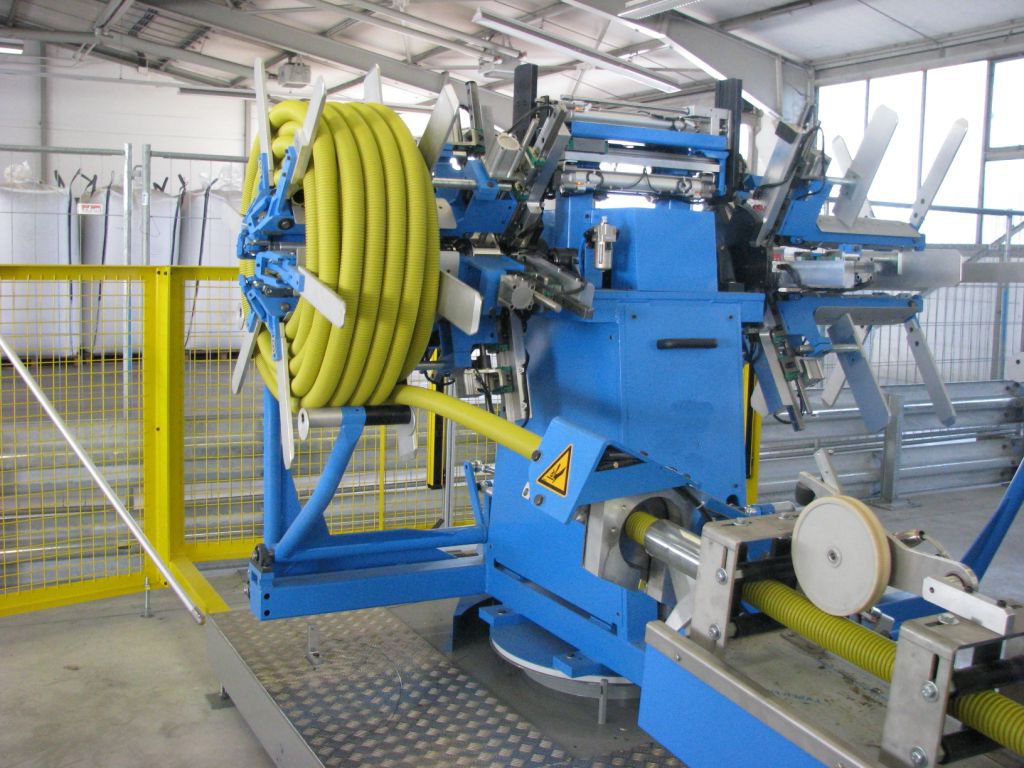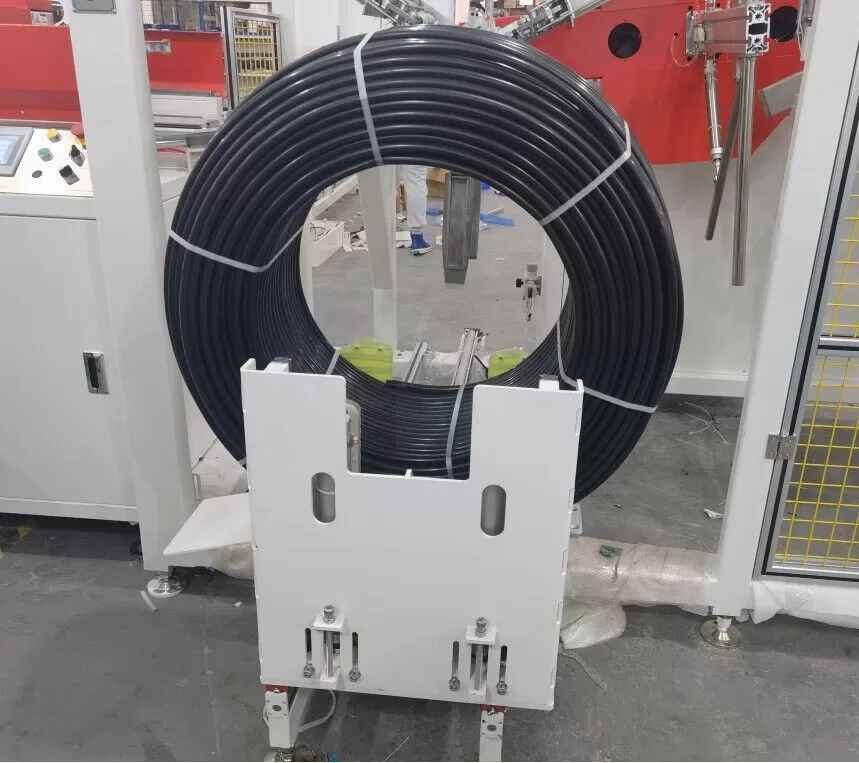Optimizing Pipe Handling: A Guide to Automatic Coiling and Film Wrapping Machines
Handling long lengths of pipe or tubing efficiently and safely is a common challenge in manufacturing and distribution. Manual coiling and packaging can be time-consuming, labor-intensive, and lead to inconsistent results. Automatic pipe coilers and film wrapping machines offer a streamlined solution, automating these critical processes for improved productivity and product protection.
This guide explores the functions, benefits, and key considerations for these automated systems.
1. Understanding Automatic Pipe Coilers
An automatic pipe coiler is a specialized machine designed to wind pipes, tubes, or hoses into neat, manageable coils without manual intervention.

How They Work
These machines typically operate using a synchronized system:
- Infeed: The pipe or tube is fed into the machine, often from an extrusion line or payoff stand.
- Coiling Head: A motorized coiling head or drum rotates, pulling the pipe and forming it into a coil of a predetermined diameter and length.
- Guiding & Tension Control: Mechanisms ensure the pipe coils evenly and maintains appropriate tension to prevent kinking or damage.
- Cutting & Ejection: Once the desired length is reached, an integrated cutter trims the pipe, and the finished coil is often automatically ejected or transferred to the next station (like strapping or wrapping).
Materials Handled
Automatic coilers can be configured for various flexible and semi-rigid materials, including:
- PE (Polyethylene) pipes
- PEX (Cross-linked Polyethylene) tubing
- Corrugated pipes
- Garden hoses
- Hydraulic hoses
- Other plastic or composite tubing
Core Benefits
- Efficiency: Drastically reduces coiling time compared to manual methods.
- Consistency: Produces uniform coils meeting specific length and diameter requirements every time.
- Labor Savings: Frees up personnel for other tasks and reduces manual handling.
2. The Role of Automatic Film Wrapping Machines for Coils
Once coiled, pipes often require protection for storage and transport. Automatic film wrapping machines, specifically those designed for coils (often horizontal stretch wrappers), serve this purpose.
How They Work
- Coil Placement: The finished pipe coil is placed onto the wrapping section, often via a conveyor or robotic arm.
- Film Application: A carriage dispenses stretch film (or sometimes other protective films) as the coil rotates or the film applicator orbits around the coil.
- Wrapping Cycle: The machine applies the film under controlled tension, often with adjustable overlap, ensuring the coil is securely wrapped.
- Film Cut & Seal: The film is automatically cut and sealed or wiped down at the end of the cycle.
Core Benefits
- Protection: Shields coils from dust, moisture, UV radiation, and scratches during handling and storage.
- Stability: Unitizes the coil, preventing it from unwinding or becoming loose.
- Improved Handling: Creates a more stable and manageable package for transport.
3. Integrated Systems: Automatic Pipe Coiling and Film Wrapping
For maximum efficiency, many operations utilize machines that combine both coiling and wrapping functions into a single, seamless process. These integrated systems handle the pipe from the initial feed through to the final wrapped coil.
Video demonstrating an example of an automatic pipe coiling and wrapping process.
Typical Process Flow
- Pipe is fed into the coiling unit.
- Coiling occurs based on pre-set parameters (length, diameter).
- Coil is automatically cut and transferred to the wrapping station.
- The wrapping unit applies protective film around the coil.
- The finished, wrapped coil is ejected, ready for palletizing or shipping.

Automatic pipe coiler & hose coiling strapping machine.jpg Key Features of Combined Machines
- Fully Automated Cycle: Minimizes manual intervention from start to finish.
- Programmable Logic Controllers (PLCs): Allow operators to easily set and adjust parameters via an HMI (Human-Machine Interface), such as:
- Pipe diameter and wall thickness settings
- Target coil length and inner/outer diameter
- Coiling speed
- Film wrapping tension and overlap
- Number of film layers
- Strapping parameters (if included)
- Adjustable Speed and Tension: Fine-tuning capabilities for both coiling and wrapping ensure optimal results for different pipe types and sizes.
- Integration Options: Can often include automatic strapping or banding units for further coil security.
- Safety Features: Equipped with guards, emergency stops, and sensors to protect operators.
4. Advantages of Automating Pipe Coiling and Wrapping

Investing in automated coiling and wrapping technology brings significant operational benefits:
- Increased Throughput: Automating the process dramatically speeds up production compared to manual handling.
- Consistent Quality: Ensures every coil meets precise specifications for length, size, and packaging integrity.
- Enhanced Product Protection: Reduces the risk of damage during storage and transit, leading to fewer rejects or returns.
- Reduced Labor Costs: Lowers reliance on manual labor for repetitive coiling and wrapping tasks.
- Improved Safety: Minimizes ergonomic risks associated with manually handling long and potentially heavy lengths of pipe.
- Optimized Material Usage: Precise control over film application reduces waste.

automatic pipe coiling machine, automatic hose coiling machine3 5. Selecting the Right Automatic Coiling and Wrapping System
Choosing the appropriate machine requires careful consideration of specific operational needs:
- Pipe/Tube Specifications: What are the diameter ranges, materials (flexibility, rigidity), and typical lengths you need to handle?
- Production Rate: What is the required output speed (coils per hour) to match your production line?
- Coil Requirements: What are the target finished coil dimensions (ID, OD, width) and maximum weight?
- Level of Automation: Do you need a standalone machine or a fully integrated system with automatic feeding, strapping, and palletizing?
- Wrapping Needs: What level of protection is required? Standard stretch film, or specific types for UV resistance or anti-corrosion?
- Available Space: Ensure you have adequate floor space and height for the machine and associated conveyors.
- Integration: How will the machine integrate with upstream (e.g., extruder) and downstream (e.g., palletizer) equipment?
- Budget: Consider the initial investment versus the long-term savings in labor, material, and improved quality.
- Manufacturer Support: Evaluate the supplier's reputation, service availability, training, and spare parts support.
Conclusion
Automatic pipe coilers and film wrapping machines are essential technologies for modern pipe and tube manufacturers and distributors. By automating these processes, businesses can achieve significant improvements in efficiency, product quality, worker safety, and overall operational cost-effectiveness. Whether choosing standalone units or fully integrated systems, carefully evaluating your specific requirements against the available machine capabilities will ensure you select a solution that delivers maximum value and optimizes your pipe handling operations.

